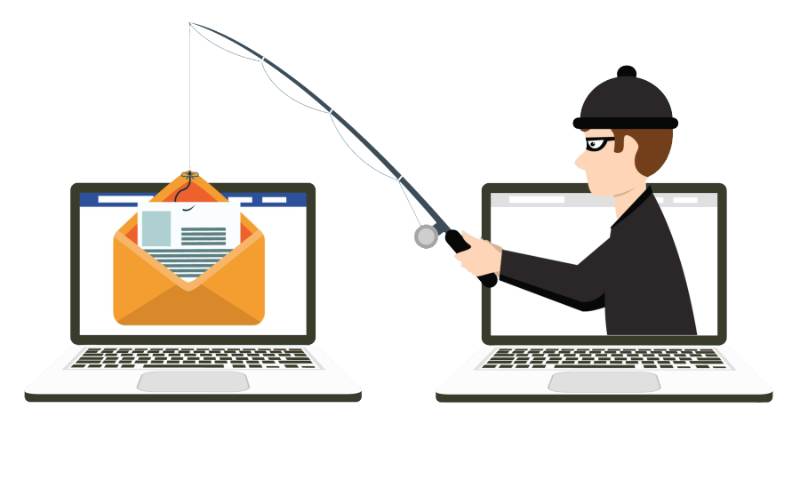Phishing attacks in blockchain are like hidden traps in a treasure hunt. You’re out there, searching for your crypto treasure when—snap!—a fake email or a spoof link tries to yank your digital gold away. Spotting these attackers is key to keeping your stash safe. Know the red flags and stop scammers cold. I’m here to guide you through the murky waters and keep your blockchain boat afloat. Let’s dive in and disarm these digital pirates together.
Recognizing the Red Flags of Blockchain Phishing Attacks
Identifying Deceptive Crypto Emails and Spoofed Blockchain Communication
You get an email saying “Your crypto account needs a security check.” Watch out! Scammers might be trying to trick you. These emails look real but don’t be fooled. Check the sender’s email address. Scammers often use an address that looks close to a real one but is just off by a letter or a period. For example, support@blockchainn.com instead of support@blockchain.com. See that extra ‘n’? That’s a big red flag.
Phishing scams cryptocurrency loves to use fear or a sense of urgency to trick you. If an email says you need to act fast or your account will be frozen, take a deep breath. Scammers want you to panic and not think straight. Always take your time and double-check everything.
Strategies for Suspicious Link Detection and Email Fraud Prevention
Links in emails can be dangerous. They might look okay but can lead you to fake blockchain sites. Hover over any link with your mouse, but don’t click it! Look at the bottom of your screen. It shows you where the link really goes. Is it the site you expect? If not, step away. It’s probably a trap.
If you’re unsure, go to the real site yourself. Type in the website address you know is true. That way, you keep your crypto account security tight.
Have good habits with your email. Don’t just open any message. Learning about blockchain transaction safety is like learning to ride a bike. At first, it’s hard. You might fall. But soon, it becomes easy, and you’re cruising safely.
Use tools that help you know if emails or sites are bad news. And always update your software. Hackers find old holes to crawl through. Keeping things fresh means keeping them out.
Think of your digital wallet like cash in your pocket. You wouldn’t just hand it over to a stranger, right? So, don’t give away your crypto wallet info either. Scammers might try to seem like a buddy, but they’re not. They want what’s yours.
Stick with me, and let’s keep your money safe from these sneaky scammers. It’s easy once you know how. Let’s beat the bad guys at their own game. Remember, being careful and smart is your best shield.
Enhancing the Security of Your Crypto Accounts and Transactions
Implementing Cybersecurity and Blockchain Best Practices
Keeping your crypto safe is like guarding a treasure chest. First, make sure you know all about phishing scams cryptocurrency folks face. Scammers are smart but you can be smarter. They send emails that trick you into giving them your crypto account info. To stop them, learn how email fraud prevention blockchain tools work. They help keep your blockchain transaction safety top-notch.
When you get an email that looks odd, it may be one of those deceptive crypto emails. Always check who sent it before you click any links. Also, keep an eye out for ledger hacking incidents. Hackers try to break into systems where your crypto is stored. And don’t forget about those sneaky smart contract vulnerabilities. Some contracts have flaws that can let thieves in. You have to be careful when you’re dealing with malicious blockchain actors.
Now, let’s say someone tries to trick you with a crypto wallet phishing attempt. The best move is to know how to spot a fake. This means identifying fake blockchain websites. They look real, but they’re set up to steal your info. And there are digital currency phishing techniques that can fool you into handing over your coins. Always be on your guard against these cons.
One big help against scammers is training to identify phishing blockchain schemes. These lessons show you how to spot trouble before it happens. And if you ever wonder about reporting blockchain phishing attempts, do it. It helps everyone stay safe.
Cybersecurity and blockchain go hand in hand. You want to keep your personal information security crypto strong. So, use smart tools to find and stop deceptive phishing methods. Phishing detection software blockchain tailored can be a big help. They watch out for bad guys trying to do phishing on blockchain platforms.
The Crucial Role of Two-Factor Authentication and Anti-Phishing Tools
The second big step is two-factor authentication blockchain style. It’s like having a secret handshake only you and your crypto account know. This makes it so much harder for thieves to get in. Think about it like your secret move in a game that keeps you safe.
And last but not least, we can’t forget about anti-phishing blockchain solutions. These tools are like your crypto’s bodyguards. They block nasty emails and links from getting to you. Want something even cooler? Phishing simulation crypto exercises can test how good you are at spotting fakes.
Before we wind up, there are a few more things to keep in mind. Always look out for phishing red flags crypto style. And be sure to use crypto exchange security tips to avoid losing your coins. By following these steps, you’ll be a pro at keeping those blockchain-based phishing attacks at bay.
Remember these tips and stay safe out there! With the right knowledge and tools, you’ll be a tough nut for scammers to crack.
Uncovering Cryptocurrency Scams: From Phony ICOs to Wallet Heists
Identifying Fake Blockchain Websites and Frauds in ICO Campaigns
Watch out for fake sites and ICO tricks. They look real but mean to steal your cash. Scammers make websites that copy real ones. Always check the website’s URL carefully. It should match exactly with the official one. If it’s off by even one letter, don’t trust it. Look for a secure lock icon next to the URL. It means the site’s traffic is encrypted. If you’re tempted by an Initial Coin Offering (ICO), pause. Many ICOs are honest, but some are scams. Scammers promise big profits and deliver nothing. Research a lot before you invest. Read reviews and reports. Ask the community about the ICO’s reputation.
Understanding the Tactics Used by Malicious Blockchain Actors
Scammers are sneaky and smart. They know many tricks to take your money. One bad trick is email fraud. Fake emails that look like they’re from a legit crypto service ask for your info. These are phishing emails. They want to steal your login keys. Never click a link in an email that feels wrong. If an email asks for your private keys or password, that’s a red flag. Real services don’t ask for your keys via email. Phishing can also happen on social media or through fake apps. Always download apps from the official app store or the service’s website.
Scammers can mess with smart contracts, too. Smart contracts are like programs that run on the blockchain. But they can have flaws, just like any software. Hackers look for these flaws to steal funds. Check smart contract audits before you trust your money with them.
Remember, crypto wallet phishing is a big problem. Scammers might make a fake wallet service. If you log in, they can access your funds. Use well-known wallets with good reviews. Protect your wallet with a strong password and never share it.
Always be alert for strange messages and links. Use tools to help spot phishing sites and emails. There are services that check if a site or an email is fishy. They are worth using to stay safe.
Training can help you see scams fast. Try phishing simulations. They are like practice drills. They teach you to see and dodge real scams.
If you think you’ve spotted a scam, report it. This helps you and others stay safe. You can report it on the service’s website or to authorities. It’s important to speak up.
Good security steps can lock down your accounts. Always update your software to fix any weak spots. Use strong, unique passwords for your crypto accounts. Add two-factor authentication (2FA) to your login steps. It adds an extra lock on your account, making it harder for thieves.
The safety of decentralized systems is in your hands, too. By knowing the risks and how to stop them, you can enjoy safe blockchain adventures. Keep learning and stay sharp for every new trick scammers try. Your funds and personal info deserve the best care and staying a few steps ahead is smart.
Developing a Defensive Skillset Against Crypto Phishing
Training and Simulation: Preparing for Phishing Attacks in the Blockchain Ecosystem
As a pro in fighting phishing, I know training is key. You must learn what to watch for. Think of it like a game where scammers send fake emails, hoping you’ll bite. They aim to steal your crypto. Don’t let them win.
In my sessions, I use real tricks from these bad guys. We go through them, step by step. You’ll see how they trick you into giving your info. By practicing, you’ll spot these tricks quick.
I’ll show you how to check every email, link, and website you get. Many look real but have small signs they’re fake. Spotting these can save your coins. For example, checking the email sender can often reveal a fraud. If it looks odd, it’s a red flag.
I also drill you in using good habits, like always double-checking URLs. And I stress never sharing your private keys. They open the door to your crypto wallet, and only you should have them.
A good way to learn is through phishing simulations. These are like practice runs. You face fake phishing tries in a safe way. This helps you be ready for the real thing. It’s like a fire drill, but for your crypto safety.
Reporting and Recovery: Steps to Take Post-Phishing Incident
Got caught in a phishing net? Act fast. The first thing you do is change your passwords. Then, check your computer for viruses. Scammers can put bad software on it to get more info.
Next, reach out to your crypto services. Tell them what happened. They can help lock down your accounts. They may also have tools to track stolen funds.
It’s just as important to tell others about the scam. This means reporting it to the right folks. You can contact groups that focus on internet crime, like the FBI’s Internet Crime Complaint Center (IC3) in the US, or other services in your country.
Remember to keep records. Take screenshots and save emails that are part of the scam. You’ll need these when you report the crime. They are like clues that can help catch the crooks.
Recovery from crypto phishing can be hard. But with fast action, you can stop the thieves from doing more harm. Work on getting back your stolen crypto. Some cases end well with funds returned. Each step matters.
Lastly, to not get tripped up by the same trick, change how you manage your info. Take the lessons you learned to heart. Get better security, like two-factor authentication, for your accounts. Stay alert and think twice before clicking. Because in the crypto space, every move counts.
In this post, we’ve tackled the sneaky world of blockchain phishing. We know the tricks phishers use, like fake emails and bogus websites. We’ve learned how to spot bad links and dodge email fraud. We’ve also talked about beefing up our crypto safety with smart moves like using two-factor authentication and anti-phishing tools.
Remember, scams like fake ICOs and wallet thefts are out there. But we can spot them. And if a phishing hook does catch us, we’ve got the skills to handle it and bounce back. Always stay sharp, report the bad guys, and help everyone stay safe. Let’s keep our crypto secure and outsmart those scammers!
Q&A :
What are phishing attacks in the context of blockchain technology?
Phishing attacks in blockchain refer to fraudulent activities where cybercriminals attempt to trick individuals into revealing sensitive information, such as private keys or wallet passwords, by masquerading as a trustworthy entity in electronic communications. This can lead to unauthorized access to blockchain accounts or wallets, resulting in the potential theft of digital assets.
How can individuals protect themselves from phishing attacks within the blockchain space?
To protect yourself from phishing attacks on blockchain platforms, it is crucial to:
- Always verify the authenticity of websites and correspondence.
- Never share private keys or sensitive information via email or untrusted websites.
- Use hardware wallets to store digital assets as they are less vulnerable to online phishing.
- Enable two-factor authentication on all related accounts for an added layer of security.
What are the common signs of a phishing attempt targeting blockchain users?
Common signs of a phishing attempt include:
- Unsolicited communications requesting private keys or personal information.
- Emails or messages containing misspellings, grammatical errors, or that come from suspicious email addresses.
- Links to websites with incorrect or misspelled URLs, or that do not use secure HTTPS connections.
- Urgent or threatening language intended to provoke immediate action without proper verification.
Why are phishing attacks particularly dangerous for blockchain users?
Phishing attacks are especially dangerous for blockchain users because transactions conducted on a blockchain are irreversible. Once digital assets are stolen through a phishing scheme, it is extremely difficult, if not impossible, to recover them. Additionally, since blockchain operates on principles of anonymity and decentralization, tracking and prosecuting perpetrators is often more challenging than with traditional financial systems.
What are some examples of phishing attacks that have occurred in the blockchain industry?
Examples of phishing attacks in the blockchain industry include:
- Fake ICOs (Initial Coin Offerings) where attackers create a counterfeit website or social media presence to solicit investments.
- Email campaigns that impersonate legitimate blockchain companies or platforms, asking users to click on malicious links or provide sensitive information.
- Social engineering tactics where attackers pose as customer support agents to extract security-related information from unwary users.
Each of these phishing attempts share the common goal of deceiving users into willingly surrendering valuable information or assets to cybercriminals.


